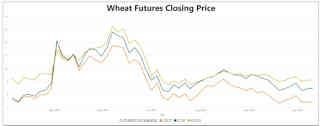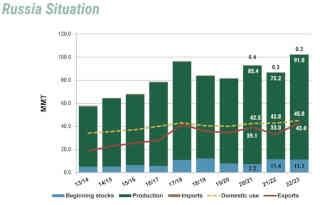By Tyllor Ledford
Following a year of dramatic volatility, several factors have pressured global wheat prices back to levels last seen before Russia’s invasion of Ukraine in early 2022. There are several factors behind this trend. In this article, U.S. Wheat Associates (USW) examines the tenacity of world wheat trade even in the face of serious market uncertainty.
In February 2022, Russia’s unprovoked invasion shook world markets, launching a season of unprecedented volatility and record prices across the agricultural sector. In response to Putin’s war, nearby Chicago Board of Trade (CBOT) wheat futures soared to $14.25/bu. Combined with record global consumption, production shortfalls, and a tightening global balance sheet, the war cast a shadow of uncertainty over the grain industry.
In May 2022, the market rallied yet again when India banned wheat exports, just days after Indian government officials assured world buyers that India would lead the charge to offset the supplies from the Black Sea and help tamp global food price inflation. CBOT wheat futures once again touched record highs of $12.77/bu.

A Black Sea Breakthrough
Flash forward to July 2022, when Russia and Ukraine, with support from the United Nations and Turkey, agreed to the Black Sea grain corridor and created the Joint Coordination Center (JCC) to facilitate exports for the region. The agreement allowed supplies trapped in Russia and Ukraine to re-enter the world market, and in response, wheat futures eased 37% from the spring’s highs.

Return to Pre-War Prices
In the months since the corridor was implemented, wheat futures have continued falling to pre-war levels. The downward pressure of steady, low-priced Black Sea wheat exports remains the primary driver. According to JCC data, since the corridor’s inception, 5.1 MMT of wheat have been shipped from Ukraine. As for Russian exports, the January U.S. Department of Agriculture (USDA) World Agricultural Supply and Demand Estimates pegged Russian wheat production at 91.0 MMT, though some private sector forecasts are upwards of 104.0 MMT. With record production, Russian exports are expected to reach 43.0 MMT, 17% above the five-year average.
A record crop from Australia has also helped ease some global supply concerns. The Australian wheat crop is rumored to reach nearly 42.0 MMT, though USDA estimates hover at 36.6 MMT.
Click here to see more...